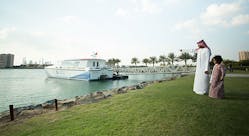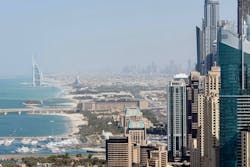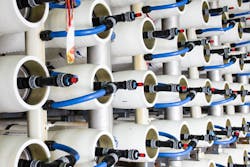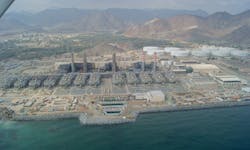An increasing amount of desalination projects along the Arabian coastline has led to a rise in salinity concentrations and has provoked environmentalists to warn about the Gulf reaching “peak salt”. How much of a concern is this issue and what is the solution?
By Jeremy Josephs
Walking on luscious green lawns and past public fountains in the United Arab Emirates and you could be forgiven for thinking that you are in Brazil, the most water rich country in the world. But you are in fact as far away from the rainforests of South America as you can imagine. This apparent reversal of the laws of nature in the Arabian desert has been achieved through desalination, now responsible for producing the majority of the water in the arid Arabian Peninsula.
However, disproportionately high levels of desalination require costly energy and the process also leaves behind brine, a highly saline solution that ends up in the sea with a potentially devastating impact on marine ecosystems. So will the issue of ‘peak salt’ - the possibility that the Gulf becomes so salty that desalinating its waters becomes economically unaffordable and environmentally unfriendly - signal the beginning of the end of desalination in the region?
Certainly not. For innovative technological solutions might well be at hand to save the desalination day. Even if, in so doing, they fail to address the more fundamental and underlying issue, both in the Middle East and elsewhere. Providers and consumers alike are singularly failing to appreciate that water is the most precious of resources, requiring conservation and respect rather than extravagance and waste.
Dr Raed Bashitialshaaer from Lund University’s Faculty of Engineering and Water Resources Engineering & Center for Middle Eastern Studies says that the Gulf is in fact “a special water body that is considered as a semi-enclosed marginal sea”.
In fact it’s more like a salt-water lake than a sea. And whereas the Pacific plummets to a maximum depth of 11,000 metres - the Gulf is just 35 metres deep on average and to make matters worse almost entirely closed.
“The huge amount of desalination projects on the Arabian coastline means increasing salinity concentrations”, Bashitialshaaer warns.
“Today’s 2.24 g/l is going to be rise considerably by 2050 if production continues as today’s trends indicate and also the fresh water entering the Gulf from the Euphrates is decreasing. This number was calculated when the total desalination on the coastline was about 21 million cubic meters per day but this has now shot up to more than 35 million and of which double this amount will be brine water. In the small area between Bahrain and Qatar the recorded salt concentration was more than 75 g/lt while the average Gulf concentration is 45 g/lt. This is clearly not a sustainable situation.”
Time, then, to apply the desalination brakes? Evidently not. For the Middle East is not just home to 70% of the world’s desalination plants - mostly in Saudi Arabia, the UAE, Kuwait and Bahrain - but tens of billions of dollars are being invested over the next few years to further expand and develop desalination in the region.
Gökçe Günel is Assistant Professor in the School of Middle Eastern and North African Studies at the University of Arizona. She coined the phrase “the infinity of water”, in relation to technological solutions in general, and desalination in particular, whereby the actors in the area are “able to envisage and embrace its infinity, regardless of existing water scarcity. Such attempts at imaging the infinity of water deny and efface the ‘natural’ characteristics of this resource.”
With Gulf states planning to almost double the amount of desalination by 2030, it raises the question of whether it is possible to come up with feasible solutions to the issue of peak salt?
The Global Clean Water Desalination Alliance, initiated by Masdar in collaboration with France and the International Desalination Assocation, launched in Paris during COP 21 and has certainly been on to the case.
With H2O minus CO2 as their catchy slogan, the Alliance is one of the few climate initiatives dealing with the water-energy nexus and climate change, with its action plan designed to see a decrease in emissions from 50 MTCO2 up to as much as 270 MTCO2 per year by 2040. But what about the issue of brine in particular?
Fatima Al Suwaidi, project engineer and applications development manager who supports the Alliance via Masdar considers that there could well be light at the end of that somewhat salty tunnel.
“Advanced environmental modelling and outfall technologies seek to minimise the environmental impact of disposing the brine to the environment. But certain regional and local conditions call for the mitigation or avoidance of brine disposal. Technologies to increase the recovery of fresh water from saline sources - brine concentration and zero-liquid-discharge (ZLD) technologies do exist, but are often associated with high costs and high energy consumption,” says Al Suwaidi.
“Moreover, most of the currently available technologies show difficulties in extracting potentially valuable components that are present in the brine at low concentrations.
“Although of course extracting such components can potentially enable economically viable brine concentration or ZLD solutions, mitigating or offsetting the brine treatment costs. This could avoid or reduce the potentially negative impacts resulting from desalination and increase the recovery of limited inland water resources. Solutions need to be economically viable to such an extent that environmental regulations are not the single driver.
“The recovery of valuable components, even if present in low concentrations, from brine should be regarded as a potential means to achieve economic viability of the solution. But at the same time these solutions should take into account the utilization or disposal of the potentially high quantities of non-valuable components such as common salts.”
Other solutions are on the table too. Farid Benyahia, a chemical engineer at Qatar University, has patented a process that could eliminate the need for brine disposal. It involves the use of pure carbon dixoide and ammonia to turn brine into baking soda and calcium chloride.
“The goal is to solve two nasty environmental problems with one smart solution and generate useful, marketable products to partially offset the cost of storing CO2,” he argues.
The secret is a variant to the Solvay process, a not-so high tech (it was developed back in the late 19th century) seven-step chemical conversion method that is widely used to produce sodium carbonate for industrial applications and which many chemists are now working flat out to refine.
Other solutions relate to dilution. This could be accomplished by discharging brine farther offshore or by mixing it with treated wastewater or power plant cooling water to reduce salinity prior to discharge.
Lund University’s Dr Raed Bashitialshaaer also thinks that Saudi Arabia would be well advised to build any new plants on its far less affected Red Sea coast.
Gökçe Günel puts it another way: “the Gulf states have to do more than artificially boost the availability of fresh water - they need to change the public perception of water from a free, endless resource to a man-made commodity that is expensive and which has to be properly managed. And to bear in mind at all times that the concept of what I refer to as the infinity of water of course doesn’t exist at all.”
Jeremy Josephs is a freelance writer for WWi magazine, based in Israel.
More Water & WasteWater International Archives Issue Articles








